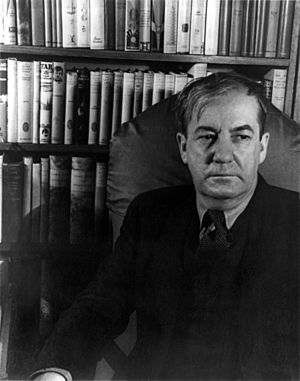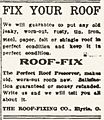Sherwood Anderson facts for kids
Quick facts for kids
Sherwood Anderson
|
|
|---|---|

Anderson in 1933
|
|
| Born | September 13, 1876 Camden, Ohio, United States |
| Died | March 8, 1941 (aged 64) Colón, Panama |
| Occupation | Author |
| Notable works | Winesburg, Ohio |
| Spouse | Cornelia Pratt Lane (1904–1916) Tennessee Claflin Mitchell (1916–1924) Elizabeth Prall (1924–1932) Eleanor Copenhaver (1933–1941) |
| Signature | |
Sherwood Anderson (September 13, 1876 – March 8, 1941) was an American writer. He was known for his unique short stories and novels. Even though he didn't finish high school, he taught himself and became a successful businessman.
Later, Anderson decided to leave his business to become a full-time writer. He moved to Chicago and wrote many books. His most famous work is Winesburg, Ohio, a collection of short stories that made him well-known. He also wrote Dark Laughter, which was his only bestseller.
Contents
Sherwood Anderson's Early Life
Sherwood Berton Anderson was born on September 13, 1876, in Camden, Ohio. He was the third of seven children. His father, Irwin McLain Anderson, was a former soldier and harness-maker.
The family moved often, and their money problems grew. By the time they settled in Clyde, Ohio, in 1884, his father struggled to find steady work. Sherwood's mother took in laundry to help the family. Young Sherwood was good at finding odd jobs to help out. People even called him "Jobby" because he was always working.
School and Reading
Sherwood was a good student, but he often missed school to work. He left school for good at age 14. He worked as a newsboy, errand boy, and helped his father paint signs. He also assembled bicycles. Even as a teenager, Sherwood was great at selling things. This skill later helped him in his advertising career.
Sherwood loved to read. Even though his family didn't own many books, he borrowed them from the school library. He also borrowed books from a school superintendent and a local artist.
Life Changes for Young Sherwood
By 1895, when Sherwood was 18, his family life was difficult. His father often disappeared for weeks. In May 1895, his mother died from tuberculosis. Sherwood was mostly on his own. He worked as a stable groom, which later gave him ideas for his stories.
In March 1895, he joined the Ohio National Guard. After his mother's death, he left Clyde. He moved to Chicago around 1896 or 1897.
Life in Chicago and Military Service
In Chicago, Sherwood lived with his brother Karl, who was studying art. Sherwood found a job at a cold-storage plant. Later, his sister and two younger brothers joined him. Money was tight, but they managed.
Sherwood decided to continue his education by going to night school. He took classes like "New Business Arithmetic" and learned about poets like Robert Browning and Walt Whitman. His time in Chicago was cut short when the United States prepared for the Spanish–American War.
Sherwood Anderson in the Spanish-American War
Sherwood returned to Clyde to join the military. He trained for several months in different camps. In early 1899, his company was sent to Cuba. However, the fighting had already stopped before they arrived. They left Cuba in April 1899 without seeing any combat.
After the war, Sherwood briefly worked on a farm. Then, he decided to go back to school. In September 1899, at age 23, he enrolled in his senior year of preparatory school in Springfield, Ohio. He did well in school and gave a speech at his graduation.
Business Career and First Marriage
While in Springfield, Sherwood lived in a boardinghouse. He met many interesting people, including a teacher named Trillena White. She introduced him to great books and later inspired some of his characters. He also met Harry Simmons, an advertising manager. Simmons was impressed by Sherwood's graduation speech and offered him a job in Chicago.
In the summer of 1900, Sherwood moved back to Chicago to start his advertising career. He worked for different advertising companies, selling ads and writing copy. He even published his first professional articles in a trade magazine. These early writings helped him develop the "character writing" style he would use in Winesburg, Ohio.
Starting a Family and Business
In 1903, Sherwood met Cornelia Pratt Lane. They married on May 16, 1904. They had three children: Robert, John, and Marion. After their honeymoon, they moved to Chicago.
In 1906, Sherwood left Chicago to become president of United Factories Company in Cleveland. This company sold various items through mail order. His new job was stressful, especially when a batch of defective incubators caused many angry letters from customers. This stress led to a difficult period for him in 1907.
Moving to Elyria and New Ventures
In September 1907, the Andersons moved to Elyria, Ohio. Sherwood started a mail-order business selling a special paint called "Roof-Fix." The business did very well. He even bought other similar businesses and expanded his company. By late 1911, he merged his companies into the American Merchants Company.
A Major Life Change
At the peak of his business success, Sherwood Anderson experienced a significant event. On November 28, 1912, he came to his office feeling nervous. He wrote a note to his wife and left the office, saying he felt "as though my feet were wet, and they keep getting wetter."
Four days later, he was found disoriented in a drug store in Cleveland. He couldn't remember who he was. A friend recognized him and took him to a hospital. This event is often called a "fugue state," where a person loses their memory and identity for a period.
Sherwood later said he might have wanted to escape his business life. He felt admired by younger writers for making such a big change. After this event, he moved back to Chicago and later divorced Cornelia. This marked the beginning of his full-time writing career.
Becoming a Novelist
Sherwood Anderson's first novel, Windy McPherson's Son, was published in 1916. His second novel was Marching Men (1917). These books came before his most famous work.
His most important work is Winesburg, Ohio (1919), a collection of connected short stories. He said the first story, "Hands," was the first "real" story he ever wrote. Anderson was also one of the first American writers to use ideas from psychology in his stories.
Later Novels and Influence
Anderson wanted to write more novels. In 1920, he published Poor White, which was quite successful. He also published Many Marriages (1923) and Dark Laughter (1925). Dark Laughter became a bestseller, his only book to reach that status during his lifetime.
In 1924, Sherwood and his third wife, Elizabeth Prall, moved to New Orleans. They hosted many other writers, like William Faulkner and Carl Sandburg. Anderson was a big influence on these younger writers.
Sherwood Anderson's Marriages
Sherwood Anderson was married four times during his life.
- Cornelia Pratt Lane: They married in 1904 and had his three children. They divorced in 1916.
- Tennessee Claflin Mitchell: He quickly married Tennessee Mitchell, a sculptor, in 1916. They divorced in 1924.
- Elizabeth Norma Prall: In 1924, Anderson married Elizabeth Prall. This marriage also ended in divorce in 1932.
- Eleanor Gladys Copenhaver: In 1928, he met Eleanor Copenhaver. They married in 1933. They traveled and studied together. They were also involved in the trade union movement.
Later Works and Final Years
Sherwood Anderson often wrote articles for newspapers. In the 1930s, he published short stories like Death in the Woods, essays like Puzzled America, and a novel called Kit Brandon: A Portrait. While some of his later works contained famous passages, they were generally not as highly regarded as his earlier books.
His novel Beyond Desire (1932) was about the trade union movement. It was set during a mill strike in Gastonia, North Carolina.
In his later years, Anderson and his wife Eleanor lived on his Ripshin Farm in Troutdale, Virginia. He bought this farm in 1927 for summer use. He also wrote columns for a local newspaper, which were later collected and published.
Sherwood Anderson's Death
Sherwood Anderson died on March 8, 1941, at age 64. He became ill during a cruise to South America. He had stomach pain, which was later found to be peritonitis. This happened because he accidentally swallowed a toothpick, which caused internal damage.
Anderson and his wife left the cruise ship and went to a hospital in Colón, Panama, where he passed away. His body was returned to the United States and buried in Marion, Virginia. His grave marker reads, "Life, Not Death, Is the Great Adventure."
Legacy and Honors
- In 1971, Sherwood Anderson's last home, Ripshin Farm, became a National Historic Landmark.
- In 2012, he was added to the Chicago Literary Hall of Fame.
- The Sherwood Anderson Foundation was created in 1988 by his children and grandchildren. It helps new writers by giving them awards and grants.
Works by Sherwood Anderson
Novels
- Windy McPherson's Son (1916)
- Marching Men (1917)
- Poor White (1920)
- Many Marriages (1923)
- Dark Laughter (1925)
- Tar: A Midwest Childhood (1926, a novel based on his own childhood)
- Beyond Desire (1932)
- Kit Brandon: A Portrait (1936)
Short Story Collections
- Winesburg, Ohio (1919)
- The Triumph of the Egg: A Book of Impressions From American Life in Tales and Poems (1921)
- Horses and Men (1923)
- Death in the Woods and Other Stories (1933)
Poetry
- Mid-American Chants (1918)
- A New Testament (1927)
Nonfiction and Essays
- A Story Teller's Story (1922, his memories)
- The Modern Writer (1925, essays)
- Sherwood Anderson's Notebook (1926, his memories)
- Alice and The Lost Novel (1929)
- Hello Towns! (1929, collected newspaper articles)
- Puzzled America (1935, essays)
- Home Town (1940, photographs and comments)
Images for kids
See also
 In Spanish: Sherwood Anderson para niños
In Spanish: Sherwood Anderson para niños





